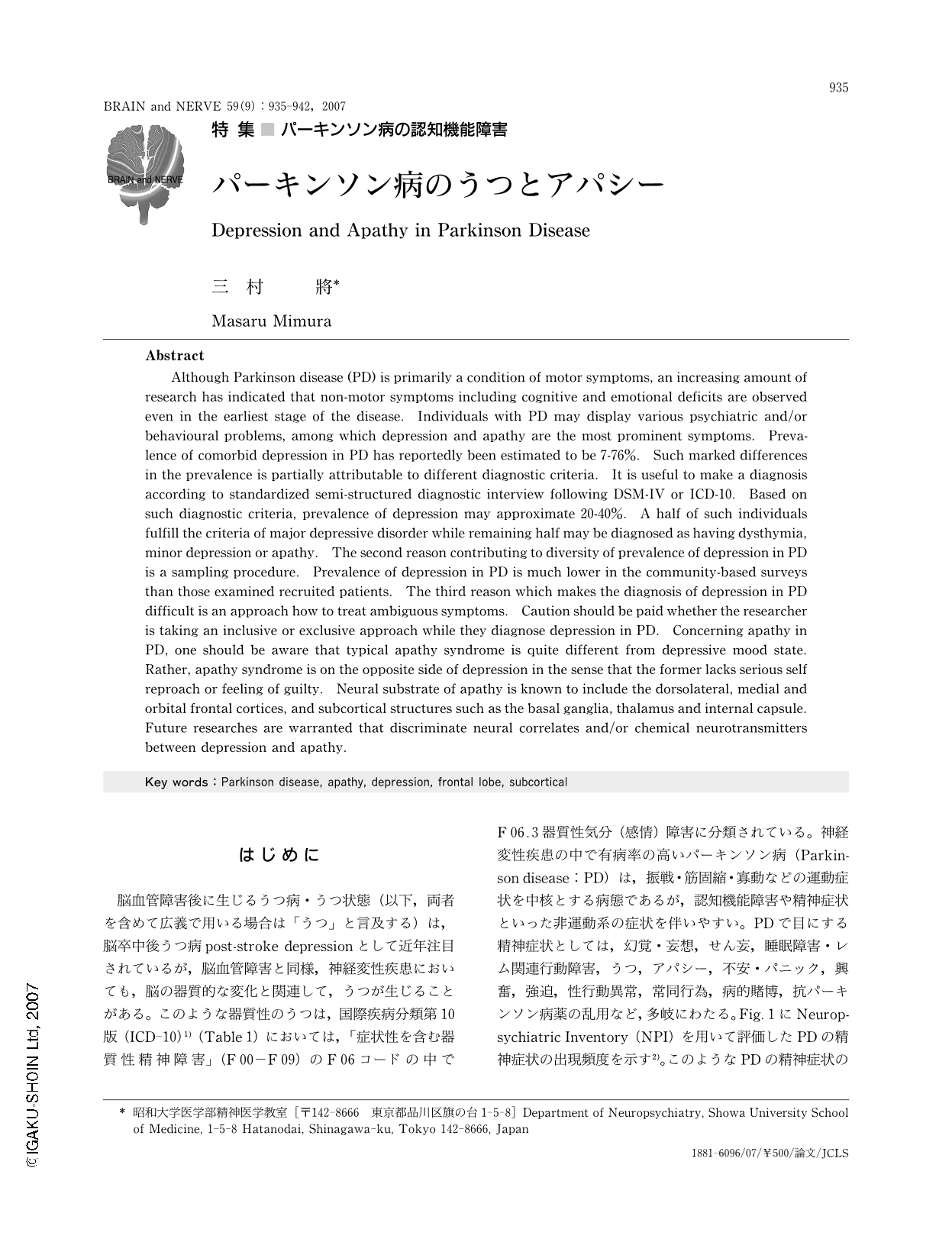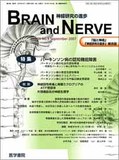Japanese
English
- 有料閲覧
- Abstract 文献概要
- 1ページ目 Look Inside
- 参考文献 Reference
はじめに
脳血管障害後に生じるうつ病・うつ状態(以下,両者を含めて広義で用いる場合は「うつ」と言及する)は,脳卒中後うつ病post-stroke depressionとして近年注目されているが,脳血管障害と同様,神経変性疾患においても,脳の器質的な変化と関連して,うつが生じることがある。このような器質性のうつは,国際疾病分類第10版(ICD-10)1)(Table1)においては,「症状性を含む器質性精神障害」(F00-F09)のF06コードの中でF06.3器質性気分(感情)障害に分類されている。神経変性疾患の中で有病率の高いパーキンソン病(Parkinson disease:PD)は,振戦・筋固縮・寡動などの運動症状を中核とする病態であるが,認知機能障害や精神症状といった非運動系の症状を伴いやすい。PDで目にする精神症状としては,幻覚・妄想,せん妄,睡眠障害・レム関連行動障害,うつ,アパシー,不安・パニック,興奮,強迫,性行動異常,常同行為,病的賭博,抗パーキンソン病薬の乱用など,多岐にわたる。Fig.1にNeuropsychiatric Inventory(NPI)を用いて評価したPDの精神症状の出現頻度を示す2)。このようなPDの精神症状の中で最もよくみられる問題はうつであり,おおむね20~40%と推測される。しかし,後述するように,典型的な大うつ病の病像を示すものは多くはなく,むしろ半分以上は気分変調症や小うつ病,あるいは発動性減退を前景とするアパシー(無感情)といった状態像に該当する。本稿では,PDにおけるうつとアパシーの診断,評価の要点を述べ,特にアパシーに関するとらえ方や責任病巣について,やや詳しく述べることとする。
Abstract
Although Parkinson disease (PD) is primarily a condition of motor symptoms, an increasing amount of research has indicated that non-motor symptoms including cognitive and emotional deficits are observed even in the earliest stage of the disease. Individuals with PD may display various psychiatric and/or behavioural problems, among which depression and apathy are the most prominent symptoms. Prevalence of comorbid depression in PD has reportedly been estimated to be 7-76%. Such marked differences in the prevalence is partially attributable to different diagnostic criteria. It is useful to make a diagnosis according to standardized semi-structured diagnostic interview following DSM-IV or ICD-10. Based on such diagnostic criteria, prevalence of depression may approximate 20-40%. A half of such individuals fulfill the criteria of major depressive disorder while remaining half may be diagnosed as having dysthymia, minor depression or apathy. The second reason contributing to diversity of prevalence of depression in PD is a sampling procedure. Prevalence of depression in PD is much lower in the community-based surveys than those examined recruited patients. The third reason which makes the diagnosis of depression in PD difficult is an approach how to treat ambiguous symptoms. Caution should be paid whether the researcher is taking an inclusive or exclusive approach while they diagnose depression in PD. Concerning apathy in PD, one should be aware that typical apathy syndrome is quite different from depressive mood state. Rather, apathy syndrome is on the opposite side of depression in the sense that the former lacks serious self reproach or feeling of guilty. Neural substrate of apathy is known to include the dorsolateral, medial and orbital frontal cortices, and subcortical structures such as the basal ganglia, thalamus and internal capsule. Future researches are warranted that discriminate neural correlates and/or chemical neurotransmitters between depression and apathy.

Copyright © 2007, Igaku-Shoin Ltd. All rights reserved.


